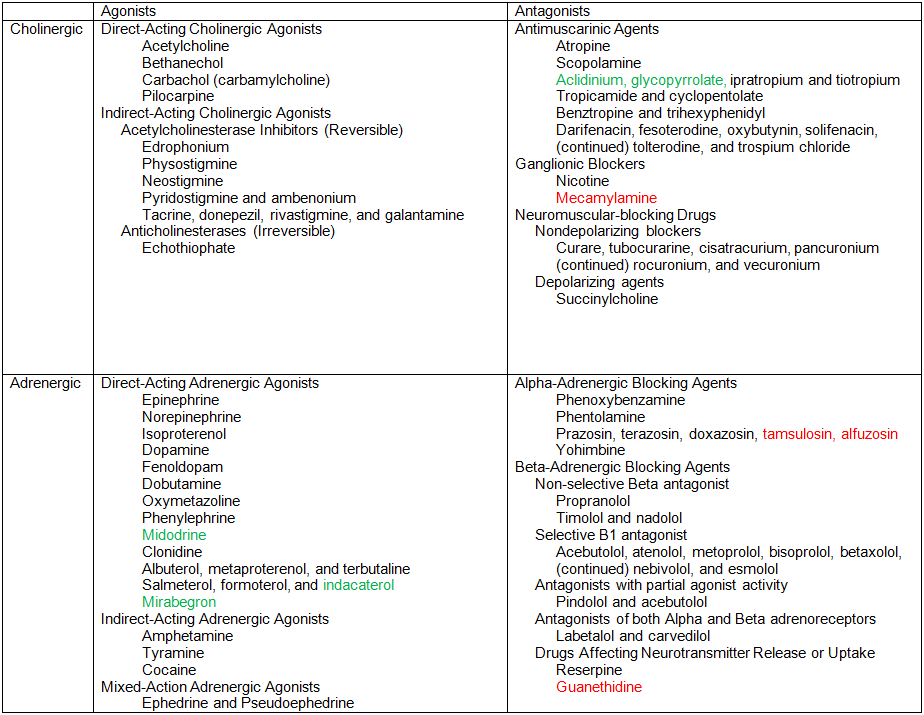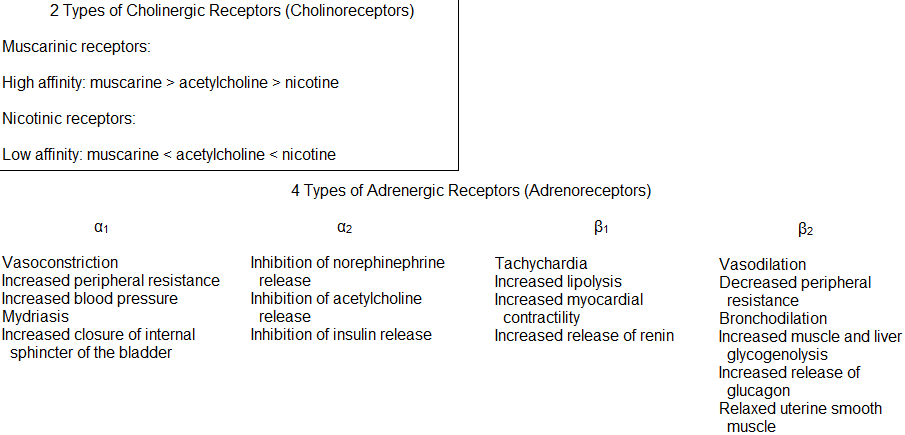Pharmacology
Pharmacokinetics: study of what the patient does to the drug.
Pharmacodynamics: study of What the drug does to the patient.
And related, is pharmacognosy, the study of finding and harvesting natural product medicines (from animals, plants, and fungi) including the study of herbal medicine.
Drug-receptor relations.
Drugs act as signals, and their receptors act as signal detectors. Pharmacology defines receptors as any biological molecule to which a drug binds and produces a measureable response. Therefore, enzymes, nucleic acids, and structural proteins, can all be considered pharmacological receptors. However, the richest type of therapeutically exploitable pharmacological receptors are proteins that transduce extracellular signals into intracellular responses. These receptors may be divided into 4 types: ligand-gated ion channels, G protein-coupled receptors, enzyme-linked receptors, and intracellular receptors.
7 types of neurotransmitters.
Communication between nerve cells, and between nerve cells and effector organs, occurs through the release of specific chemical signals, called neurotransmitters, from the nerve terminals. So although over 50 types of signal molecules (neurotransmitters) in the nervous system have been identified, only 7 are most commonly involved in the action of therapeutically useful drugs: norepinephrine, epinephrine, acetylcholine, dopamine, serotonin, histamine, and GABA.
Drugs affecting the autonomic nervous system.

Note: red = removed from the market, green = new. Red can be found in 2012 and 2015 textbooks, and green can be found in 2015 and 2019 textbooks. Metaproterenol was removed in a 2015 as a standalone, and readded in a 2019 textbook in a category with others.
Drugs that affect the autonomic nervous system, being divided into 2 groups: the cholinergic drugs, that act on receptors that are activated by acetylcholine, and adrenergic drugs, that act on receptors activated by norepinephrine or epinephrine. The autonomic nervous system, is part of the afferent division of the peripheral nervous system.
Drugs that affect the central nervous system, can be divided into 8 types: neurodegenerative diseases, anxiolytic and hypnotic drugs, CNS stimulants, anesthetics, antidepressants, antipsychotic drugs, opioids, and epilepsy.
Cholinergic receptors are stimulated by acetylcholine, while adrenergic receptors are stimulated by norepinephrine and epinephrine.

The above 2 tables are for agonists only.
Select case studies.
Caffeine.
Caffeine is the widely most used psychomotor stimulant for the central nervous system in the world, with nicotine as 2nd. The highest concentration is in coffee, but is also in cola drinks, chocolate, and tea. Caffeine has a mild diuretic action that increases the amount of sodium, chloride, and potassium in urine.
1 to 2 cups of caffeine (100 to 200 mg) causes a decrease in fatigue and increased mental alertness as a result of stimulating the cortex and other areas of the brain. 12 to 15 cups (1.2 to 1.5 g) produces anxiety and tremors. The spinal cord is not stimulated until 2 to 5 g. The lethal dose is 10 g, which induces cardiac arrhythmias (irregular heartbeat). Lethargy, irritability, and headache occur when routinely consuming more than 600 mg a day (6 cups), and then suddenly stop.
Caffeine is believed to increase the central effectiveness of acetaminophen and aspirin. Caffeine is categorized as a methylxantine, under CNS stimulants. Other methylxanthines include theophylline (found in tea), and theobromine (found in chocolate).
Sugar.
High sugar causes you to pee often. Cancer loves sugar.
Antibiotics.
Clinically-useful anti-bacterial drugs are divided into 7 types: penicillins, cephalosporins, tetracyclines, aminoglycosides, macrolides, and fluoroquinolines, and a 7th category being labeled “other.” The 1st 2 are cell wall inhibitors, whereas the next 3 are protein synthesis inhibitors (which targets the bacterial ribosome).
The last 2 examples, are part of 5 main mechanisms by which antibacterial agents act:
1. Inhibition of cell metabolism (best known examples are sulphonamides).
2. Inhibition of bacteria cell wall synthesis (examples as mentioned, penicillins and cephalosporins, as well as glycopeptides such as vancomycins).
3. Interactions with plasma membrane (such as polymyxins and tyrothrycin, and triethylene glycol and propylene glycol).
4. Disruption of protein synthesis (as already mentioned, tetracyclines, aminoglycosides, and macrolides (such as erythromycin), as well as, rifamycins and chloramohenicol).
5. Inhibition of nucleic acid transcription and replication (such as nalidixic acid and proflavine).
Chemicals like bleach and hydrogen peroxide do #1 and #3, with weakly on #4.
History of antibiotics.
The 1st class of antibacterials was Penicillin discovered in 1928, but didn’t become into use until 1942. (The original Penicillin discovered was benzylpenicillin, or penicillin G.). They are a type of ß-Lactam antibiotic.
The 1st class of antibacterial was a red dye called prontosil, in 1935, a class of drugs called sulphonamides, against streptococcal infections. Now this drug was only effective in vivo, and not in vitro. That is, it did not kill bacteria in a test tube, only in a mammal’s intestines. That is, in the animal’s intestines the prontosil was metabolized by bacteria to give a product called sulphonamide – the true antibacterial agent, which was effective against some Gram-positive bacteria. This was the only effective drug until Penicillin came to the public market. Then in 1944, the antibiotic streptomycin was discovered from a systematic search of soil organisms, which extended to the range of Gram-negative bacteria.
Bacteria constantly remodel their peptidoglycan cell walls, simultaneously building down and breaking down portions of their cell wall as they grow and divide. ß-Lactam antibiotics prevents the formation of peptidoglycan cross-links in the cell wall, so the cell rapidly dies. Examples of these antibiotics are penicillins and cephalosporins. Up until 2003, by sales, more than half of all commercially available antibiotics is use were ß-Lactam compounds. The 1st cephalosporin (cephalosporin C) was derived from a fungus obtained in the mid-1940s from sewer waters on the island of Sardinia, when an Italian professor noted the waters surrounding the sewage outlet periodically cleared of microorganisms.
The 1st antibiotic to find therapeutic application in tumor chemotherapy is Dactinomycin (Cosmegen). 1 of the most important and widely used anticancer drugs is Doxorubicin (Adriamycin).
Antiviral drugs.
The 1st antiviral drug was Aciclovir, an antiretrovirus drug, discovered in 1977, and used for the treatment of herpes simplex virus infections, chickenpox, and shingles. It was introduced to the market in 1981.
The 1st agent available for treatment of HIV infections is the pyrimidine analog, Zidovudine (Retrovir), a class of nucleoside reverse-transcriptase inhibitor, approved in 1987, followed by Didanosine, in 1988.
The 1st antiviral drugs for herpes infections were idoxuridine and vidarabine, and the 1st for influenza A was amantadine.
The 2nd class of retroviruses developed were protease inhibitors. The 1st members of this class were Saquinavir (Invirase) and Ritonavir (Norvir), approved in late 1995-1996. Within 2 years, annual deaths from AIDS in the U.S. fell from over 50,000 to around 18,000.
Deuterated drugs.
Deuterated drugs are drugs that have at least 1 hydrogen replaced with a deuterium. The 1st deuterated drug that was approved by the FDA was deutetrabenazine, on April 3, 2017, sold as Auestedo. It was made by Teva Pharmaceuticals. It's a vesicular monoamine transporter 2 inhibitor used for the treatment of chorea associated with Huntington's disease and tardive dyskinesia. The non-deuterium version of this drug, tetrabenazine, was approved by the FDA in 2008.
When hydrogen are replaced with deuterium, the drug still does the same thing in terms of binding to receptors and having the same pka. The main difference, is heavier mass leading to less rotations. Therefore, deuterated drugs can be detected by MRR (molecular rotational resonance). 2 other things that are different with deuterated drugs, is slower drug metabolism (and therefore have a longer half-life, which allows for less frequent dosing), and slower epimerization.
Deuterated drugs lead to the concept of enantioisotopomers, which are molecules that are chiral solely due to the deuterium substitution.
Mifepristone (for abortions).
The FDA approved mifepristone in 2000 as a safe and effective way to end early pregnancies (sold as Mifeprex, and taken by mouth). Since 2000, roughly 6 million patients have taken mifepristone, according to the FDA.
In 2016, FDA loosened restrictions on the drug to allow it to be prescribed up to 10 weeks of pregnancy and allowed nurses and other medical professionals to prescribe it. In 2021, the agency said the drug could be sent through the mail, doing away with a longstanding requirement that women pick the drug up in person. A 2021 review of agency records looking for deaths that were likely related to the drug identified 13, or .00027% of patients. In 2023 the pill was used in more than 6 in 10 of the abortions in the U.S.
Pharmacology: Mifepristone is a progesterone antagonist. Taking this drug in early pregnancy usually results in abortion of the fetus due to interference with the progesterone needed to maintain pregnancy. Progesterone, the natural progestogen, is produced in response to luteinizing hormone by females secreted from the corpus luteum primarily during the 2nd half of the menstrual cycle, and by the placenta.
The most common prescription and over-the-counter drugs in the U.S., in 2009.
1. Hydrocodone/acetaminophen (painkiller) active ingredient in Tylenol, sold as Vicodin.
2. Simvastatin (high cholesterol) (Zocor)
3. Lisinopril (high blood pressure) [ace inhibitor] patent expired
4. Levothyroxine sodium (thyroid disorders)
5. Azithromycin (antibiotic) Zithromax
6. Metformin (diabetes) Glucophage [lowers blood sugar levels]
7. Lipitor (high cholesterol)
8. Amlodipine (high blood pressure) [calcium channel blocker] Norvasc
9. Amoxicillin (antibiotic) millions of kids get it for ear infections, although caused by viruses
10. Hydrochlorothiazide (high blood pressure)
11. Omeprazole (heartburn) Prilosec (now available without a prescription)
12. Alprazolam (anxiety) originally Xanax, surpassed Valium in the late ‘80s.
13. Furosemide (high blood pressure) diuretic water pill.
14. Metoprolol tartrate (angina, high blood pressure) Toprol [beta blocker]
15. Atenolol (angina, high blood pressure) 1st beta blocker
Note: this list should not be confused with a prescription-only or over-the-counter only drug list.
-
The 1st U.S. state for pharmacists as medical providers.
In 1979, Washington became the 1st state in the U.S. to enact legislation allowing for the formation of collaborative practice agreements, or CPAs. Under the agreements, a licensed prescriber such as a physician or a nurse practitioner can delegate to a pharmacist the authority to prescribe a given drug and administer it to patients. In 2015, Washington's Gov. Jay Inslee signed a law making Washington the 1st state to formally recognize pharmacists as medical providers and require that they not be excluded from health insurance provider networks.
Advertisement of prescription drugs.
The U.S. and New Zealand are the only 2 countries in the world that allow for advertisement of prescription medicine. They both allow direct to consumer advertising (DTCA) of prescription medications through various media channels such as TV, social media, and print. An estimated $10 billon was spent in 2016 alone for that.
Imports to USA from other countries.
In 2024, the U.S. imported nearly $233 billion in pharmaceutical and medicinal products, according to the Census Bureau, or $213 billion according to the United Nations Comtrade Database. Data from the MIT Observatory of Economic Complexity identified Ireland, Germany, Switzerland, Singapore and India as the top 5 exporters of pharmaceuticals to the U.S. in July 2025. The EU accounts for around 60% of all US pharma imports in 2024.
News.
7/13/2023.
Today, the U.S. Food and Drug Administration approved Opill (norgestrel) tablet for nonprescription use to prevent pregnancy— the 1st daily oral contraceptive approved for use in the U.S. without a prescription. Approval of this progestin-only oral contraceptive pill provides an option for consumers to purchase oral contraceptive medicine without a prescription at drug stores, convenience stores, grocery stores, and online.
7/11/2024 Pfizer.
The company announced encouraging data from an ongoing early-stage trial of its obesity pill, danuglipron, which belongs to a class of drugs called GLP-1 receptor agonists that have shown remarkable efficacy in reducing body weight, and with a patient, friendly oral formulation.

